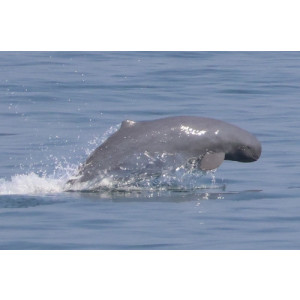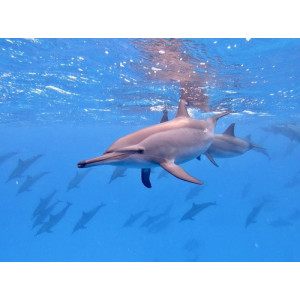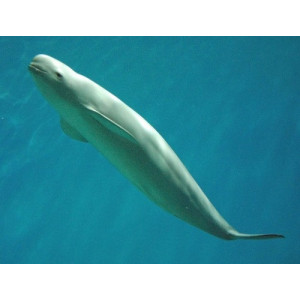Ganges River Dolphin Did you see this animal?
Scientific Name : Platanista gangetica
Family : Platanistidae
Order : Cetartiodactyla
Class : Mammalia
Phylum : Chordata
Other Name : Ganges Dolphin, Blind River Dolphin, South Asian River Dolphin
Habitat : Wetlands (inland), Marine Neritic
Description : The Ganges River Dolphin is one of the smallest dolphin species, reaching an average length of 6-8 feet (2-2.5 meters) and weight of 150-300 pounds (70-135 kg).
It has a long, slender body with a slightly rounded head, a long beak, and small eyes. Its skin is a bluish-gray color, and it has a distinctive hump on its back.
The Ganges River Dolphin has several adaptations to its freshwater habitat, including a streamlined body shape, a flexible neck that allows it to move in shallow water, and long, sensitive snouts that can detect prey in murky water.
The Ganges River Dolphin is primarily a fish-eater, feeding on a variety of freshwater fish species such as catfish, carp, and eel. It is also known to eat crustaceans and mollusks.
The Ganges River Dolphin is found in freshwater rivers and their tributaries, including the Ganges, Brahmaputra, and Meghna rivers. They prefer deep pools with slow-moving water and a muddy bottom.
The Ganges River Dolphin is a solitary animal, and little is known about its social behavior. They are known to be shy and elusive, and they are rarely seen by humans.
The Ganges River Dolphin is classified as Endangered by the IUCN Red List, with an estimated population of less than 5,000 individuals. Threats to their survival include habitat loss and degradation, pollution, and overfishing. Conservation efforts are underway to protect their habitat and promote sustainable fishing practices.
It has a long, slender body with a slightly rounded head, a long beak, and small eyes. Its skin is a bluish-gray color, and it has a distinctive hump on its back.
The Ganges River Dolphin has several adaptations to its freshwater habitat, including a streamlined body shape, a flexible neck that allows it to move in shallow water, and long, sensitive snouts that can detect prey in murky water.
The Ganges River Dolphin is primarily a fish-eater, feeding on a variety of freshwater fish species such as catfish, carp, and eel. It is also known to eat crustaceans and mollusks.
The Ganges River Dolphin is found in freshwater rivers and their tributaries, including the Ganges, Brahmaputra, and Meghna rivers. They prefer deep pools with slow-moving water and a muddy bottom.
The Ganges River Dolphin is a solitary animal, and little is known about its social behavior. They are known to be shy and elusive, and they are rarely seen by humans.
The Ganges River Dolphin is classified as Endangered by the IUCN Red List, with an estimated population of less than 5,000 individuals. Threats to their survival include habitat loss and degradation, pollution, and overfishing. Conservation efforts are underway to protect their habitat and promote sustainable fishing practices.
Distribution in Bangladesh
References:
description written by:Asad U. Tanvir,Department of Zoology,Jagannath University,Dhaka; reviewed by:Muntasir Akash,Department of Zoology,University of Dhaka;Taxonomic Checklist:Red List of Bangladesh Volume 2: Mammals, 2015, IUCN; information sources:wikipedia,iucnredlist.org; photo credit:Fábio Olmos(www.inaturalist.org/people/Fábio Olmos), photo copyright: iNaturalist.more information please contact with us.
description written by:Asad U. Tanvir,Department of Zoology,Jagannath University,Dhaka; reviewed by:Muntasir Akash,Department of Zoology,University of Dhaka;Taxonomic Checklist:Red List of Bangladesh Volume 2: Mammals, 2015, IUCN; information sources:wikipedia,iucnredlist.org; photo credit:Fábio Olmos(www.inaturalist.org/people/Fábio Olmos), photo copyright: iNaturalist.more information please contact with us.




































